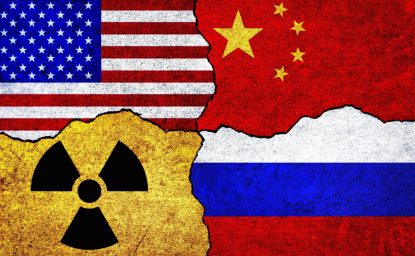 One day, in the middle of the previous century, top executives with Ringling Brothers Circus decided it was time to rejuvenate their animal acts. The idea emerged to have elephants dance a polka. Ringling Brothers accordingly hired a composer to write a new elephantine polka, and sought a dance instructor to choreograph this new act. The composer was Igor Stravinsky; the choreographer: George Balanchine.
One day, in the middle of the previous century, top executives with Ringling Brothers Circus decided it was time to rejuvenate their animal acts. The idea emerged to have elephants dance a polka. Ringling Brothers accordingly hired a composer to write a new elephantine polka, and sought a dance instructor to choreograph this new act. The composer was Igor Stravinsky; the choreographer: George Balanchine.
The tale of how one of the 20th century's leading composers, and perhaps the leading choreographer of all time, came to work with elephants in Florida reveals a great deal about American culture, as well as about what those who work in the arts-both immigrant and native-have to do to earn a living in the United States. More importantly, Stravinsky, Balanchine, and their pachyderm polka demonstrate the myriad and unexpected ways in which Russians have shaped American performing arts.
During the past year, in an attempt to demonstrate that Russia still "matters" to the United States more than a decade after the collapse of the Soviet Union, the Kennan Institute organized Kultura, a four-part series exploring Russian influences on American performing arts. Participants in these seminars spoke of what is generally known and acknowledged—Russian figure skaters, ballet dancers, and symphony orchestra musicians are ubiquitous in contemporary American life—as well as much that has been long forgotten or scarcely acknowledged such as Russian expatriates training American circus elephants.
 Steve Wilhite, (pictured here) an actor at the Stanislavsky Theater Studio, performs a scene from Dostoyevsky's The Brothers Karamazov at the Wilson Center on October 10, during the Kultura session on theater.
Steve Wilhite, (pictured here) an actor at the Stanislavsky Theater Studio, performs a scene from Dostoyevsky's The Brothers Karamazov at the Wilson Center on October 10, during the Kultura session on theater.
Russian influence has reached deep into the American cultural landscape. Russian performers traveled extensively throughout small-town America in the era before electronic media. Anton Rubenstein's extensive tour of one-night stands in the 1870s brought classical music to the American "sticks" for the first time and defined piano performance for American ears in the process. A generation later, Anna Pavlova's and Mikhail Mordkin's barnstorming ballet companies shocked many an American hamlet with their scant costumes and dramatic performances on vaudeville stages and in beer halls. Native-born American dancers eventually had to begin to Russify their names to find bookings in large swaths of the American Midwest and South. Petr Tchaikovsky wrote home excitedly during the 1890s that, in America, he had at last found his audience.
The list of American thespians trained in the "method" of Konstantin Stanislavsky (or in an American distillation of translations of some of Stanislavsky's works) would account for many a star on Hollywood Boulevard. American icons Clint Eastwood, Jack Nicholson, and Marilyn Monroe all cited ŽmigrŽ acting coach Michael Chekhov among their most valued influences. Chekhov, a nephew of playwright Anton Chekhov, fled Moscow in 1928, making his way across Europe before settling in England. He came to the United States during World War II, arriving in New York (where he trained Yul Brynner, another Russian emigre) and continuing on to Southern California. His American career included a 1954 Academy Award-nominated performance in Alfred Hitchcock's Spellbound.
Stanislavsky's and Chekhov's influences extend much further across the American stage than a mere list of their students and protŽgŽs might imply. The two men, who worked together closely for some three decades in Moscow, came to represent alternative visions of modern theater that have arguably shaped American drama performance for more than a half-century.
Stanislavsky's efforts to bring a character's inner life to center stage transformed our concept of stage presentation, opening the door to a new type of drama that relied less on dialogue and more on non-verbal acting. Chekhov, meanwhile, developed acting exercises that motivate performers to this day.
Russian influences on American film, though heavily circumscribed by the decades of the Cold War, are not limited to the theatrical legacies of Balanchine, Stanislavsky, and Chekhov. Soviet film director Sergei Eisenstein was famed for his editing techniques and use of montage sequences, an influence visible in such well-known scenes as the shower sequence in Alfred Hitchcock's Psycho. Francis Ford Coppola has stated he found artistic inspiration in Eisenstein's October and Ivan the Terrible. Today, Russian influences can be seen in animation and documentary films.
Russian performers reshaped American culture because the boundary between "high" and "popular" culture was less tightly drawn than in Europe. George Balanchine could choreograph for circus rings, Hollywood sound studios, and the Broadway stage even as he reinvented and reinvigorated classical dance. Adolph Bolm-who eventually helped to establish both the San Francisco and the Chicago ballet companies-drew fresh energy from American populist approaches to the arts; meanwhile, Serge Koussevitzky found nothing unusual in cultivating American composers and conductors from the deep recesses of the American countryside.
Some Russians—such as Balanchine, Koussevitzky, and actor Chekhov—became towering cultural figures as they visibly redefined various American performing art forms. Hundreds of other Russians who ended up on American shores exerted a much subtler and quieter influence through teaching. Over the past century, millions of young Americans have learned how to dance, skate, play music, and act from Russian emigres.
When considering Russian influence on American culture, it is important to remember that Russia, like the United States, is, and has long been, a diverse and multicultural society. Among the group of great artistic figures whom Americans see as "Russians," there are Ukrainians, Georgians, and many other ethnic groups. Balanchine, Rubenstein, and Mordkin were not ethnic Russians, nor are many of the great "Russian" conductors now leading American orchestras-such as Valery Gergiev and Yuri Temirkanov. The cultural achievements, both high and low, of Imperial Russia and the Soviet Union are the consequence of a blending of confessions, ethnicities, linguistic groups, and cultures. When reflecting on the power of creative performances from those lands that once constituted the tsarist Russian empire to recast American culture, one can as easily use adjectives such as "Jewish," "Ukrainian" and "Georgian."
An examination of Russian influence on American performing arts begins to suggest some of the profound ways in which Russia "matters" to America. The depth of cultural interaction has long been either limited to a short list of luminous stars-Koussevitzky, Stravinsky, Nabokov-or largely ignored.
Interestingly, some Russian innovators in the arts have become so closely identified with American culture that their ties to Russia are simply forgotten. George Balanchine, after all, was one of the first recipients of the Kennedy Center Honors for contributions to American arts. And who could be more "American" than Irving Berlin, yet he was a child of the Russian empire.
Our tour through Russian influences on American performing arts reminds us of Ambassador George F. Kennan's wisdom and insight when, in speaking before a dinner honoring the 25th anniversary of the Kennan Institute on October 4, 1999, he observed: "When it comes to the relationship between great peoples, that relationship is not complete when it only consists of the military relationship, the economic, and the political. Particularly in the case of Russia, there has to be another supplementary dimension to these relations-and that is the dimension of the meeting of people in the work of the intellect, in the respect for scholarship and history, in the understanding of art and music, and in all the intuitive feelings that go to unite us even in the most difficult times to many people in Russia."
Related Links




